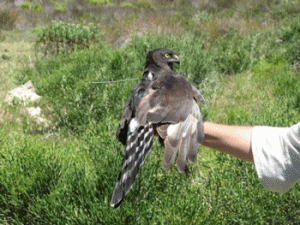First satellite tag for African raptor (Rob Simmons)

The exciting news is that the first African harrier has been successfully satellite tagged in South Africa.
The tiny (12.5g) satellite tags I have for following Black Harriers was charged up in early October 2008 and the first one attached to a breeding male in the West Coast National Park, South Africa on 11 October with the help of Phoebe Barnard and Esme Beamish.
The device is attached with a harness to the bird (see photo) and then 5 to 10 fixes a day (mainly in a 5 h block in the afternoon) show where the bird is (to within about 1 km).
I have attached a Google Earth image of his tracks from 19 -23 October. Many are of low resolution or accuracy but some good ones show he is foraging in farmland at least 17 km from his nest – a huge surprise given that we have never seen conventionally radio-marked males (inland at Bontebok National Park) farther than 3 km from their nest sites!
We hope to pop another 2 transmitters on before the end of October and the whole process may be filmed by a local company. The really exciting times come when the birds leave their breeding grounds in December/January and head north to destinations unknown. Because each transmitter is solar powered we should be able to follow these birds for more than a year!
Special thanks to all those who made this possible- Natural Research (UK) for funds, (especially Mike McGrady and Ruth Tingay), Keith Bildstein and Dave Barber at Hawk Mt (USA) for transmitters and advice, and Francois Mougeot and Beatriz Arroyo for teflon and valuable input.
I am often asked:
(1) how they are fixed to the bird and
(2) the costs.
1. Teflon ribbon is tied to the small transmitter and a small loop put over the bird’s head with a “tie” knot at the end (this knot is super-glued to stop it slipping once in place). The transmitter sits on the mantle of the bird, the “tie” knot under the crop and the remaining ends go up around the birds body to be tied again onto the transmitter. One finger’s worth of play in the teflon ribbon should be available for the bird to operate normally.
2. The cost is substantial! Each transmitter is worth US$3000 and the download time from the Argos satellites that orbit over the poles is about $1200 per year. Getting outside funding is thus essential at today’s exchange rates. However the rewards are great!
The first raptor to be followed was a Steppe Eagle – by Bernd Meyburg – who showed it went from Germany into Zambia where the species had not been previously recorded. The second was a Wahlberg’s eagle tagged in n Namibia which flew to Northern Cameroon and then directly back to the same nest it had used and been caught near the previous year!
Other European raptors have been tracked flying into Africa on a regular basis:
Spanish Eleanora’s Falcons fly right across Africa to their non-breeding grounds in Madagascar, Dutch researcher Christiane Trierweiler is following Montagu’s Harriers across the Sahara into Senegal where they spend the boreal winter in the Sahel, and French researcher Dr Francois Mougeot is following Pallid Harriers from Kazakstan into Sudan (and occasionally India).
That meeting of the Sahara desert and savannas from the south are clearly a highly important part of Africa for everyone’s raptors.
I hope to keep you updated in the meantime on the daily life of globally vulnerable Black Harriers breeding in western South Africa.
very best
Dr Rob Simmons
FitzPatrick Institute,
University of Cape Town,
Rondebosch 7701
South Africa





Hi there…
Wow! How exciting! I am very interested to see where and how far the harriers move in summer…
I am now in the second year of my research on African Grass-Owls in Gauteng & Mpumalanga. It is going quite well after a slow start to the project last year, and the owls are now breeding. My project currently focusses on research into the species habitat and prey. I am, however, hoping to fit tracking devices onto a few birds in 2010 as the biggest gap in our knowledge of the species is its range requirements. Do you have any advice for me with regards to this – As a Masters student (from next year onwards – hopefully, hehe) I will obviously be limited in terms of my budget, and suspect that satellite tags will be out of the question for my purposes… I also doubt that I would need something as powerful as a satellite tag, as the grass-owls do not travel such great distances (at least we think they dont…). However, I also think that using a conventional VHF tag may be quite limiting and difficult to track owing to undulating terrain and the thick vegetation that these owls roost in during the daytime. What would you recommend for my project?
Thanks for the post (and a great site!)
Matt Pretorius
(Tshwane University of Technology)
Hi Owlman,
Using satellite tags to track and record short-term movements of Grass Owls is probably unrealistic in terms of funds and accuracy.
The accuracy the sat tags will give you – at best – is within about 150 m, so for the expense this may not even give you the roost site!
The ideal set up would be a GPS transmitter that records as accurately as convential GPSs (to ~5-10 m), but as technology stands at present it will be too heavy for a 500g Grass Owl (> 5% of body weight).
So you are between a rock and hard sell!
There is no easy solution to this unless there is new technology that brings the weight of a GPS transmitter down…. any one out there with a good solution for Matt?